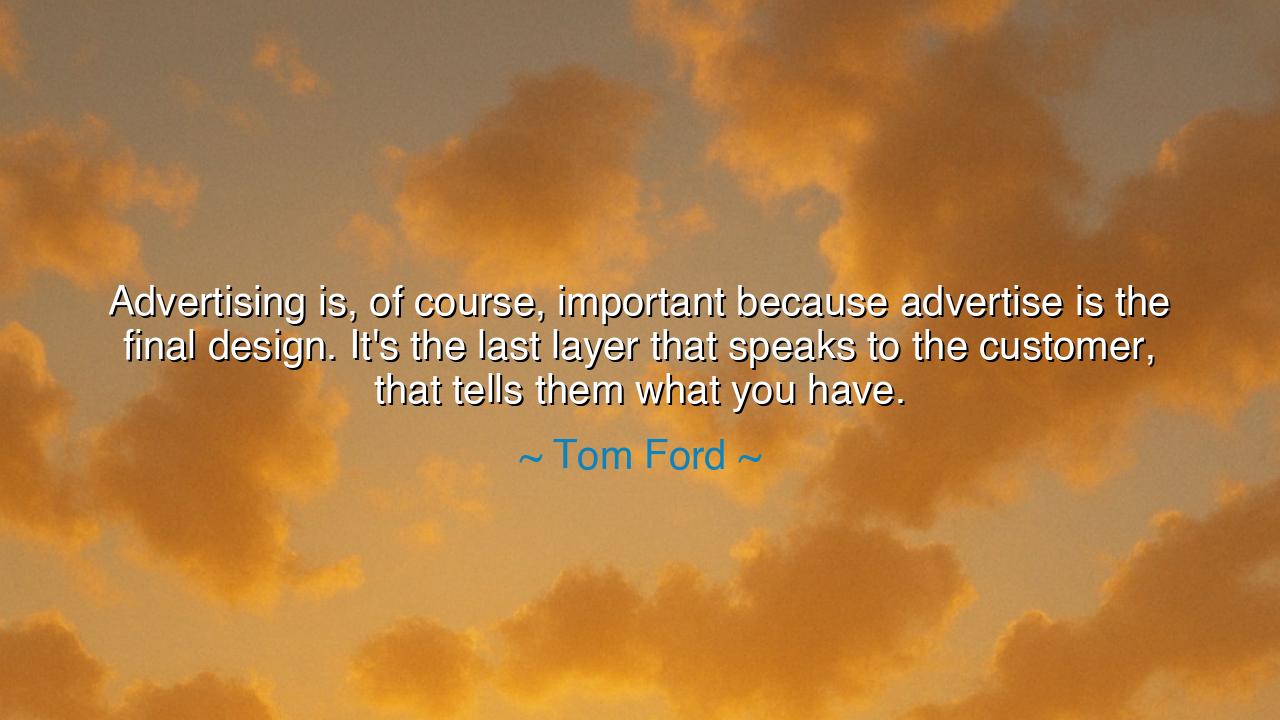
Advertising is, of course, important because advertise is the
Advertising is, of course, important because advertise is the final design. It's the last layer that speaks to the customer, that tells them what you have.






In the words of Tom Ford, the modern master of elegance and reinvention, there resounds a truth that transcends fashion and commerce alike: “Advertising is, of course, important because advertise is the final design. It’s the last layer that speaks to the customer, that tells them what you have.” These words, though spoken in the language of business, carry the rhythm of artistry. For in Ford’s philosophy, advertising is not deception, but revelation — the final act of creation, where the artist turns to face the world and say, “Here is what I have made. Here is what I believe.”
The origin of this wisdom lies deep within Ford’s own journey — from his early days as a designer at Gucci, where he revitalized a fading brand into a global icon, to his later triumphs as the founder of Tom Ford, a name now synonymous with precision and power. Ford understood that design does not end with the product itself. The suit, the fragrance, the film — all are incomplete until they are communicated, until they are seen. The final design, as he calls it, is the way a creation enters the human heart. It is the bridge between the maker and the world, between vision and understanding. Without it, even the most beautiful creation may remain unseen — a song unheard, a flame without witness.
When Ford says that advertising is the final layer, he is not speaking merely of posters, slogans, or glossy images. He speaks of the art of storytelling, of how meaning is conveyed to those who behold what we have made. Every creation — whether a product, a poem, or a cathedral — must find its language. It must explain itself not in words, but in emotion. Advertising, in Ford’s vision, is that language — the crafted message that draws the gaze of the world, that whispers to the soul of the beholder: “This is who I am. This is why I matter.”
History, too, bears witness to this truth. Consider the Renaissance, when artists like Leonardo da Vinci and Michelangelo worked not in isolation but under the patronage of the powerful. Their frescoes, their sculptures, their designs for churches and courts — all were forms of advertising in the truest sense. They were not only art; they were statements of identity, of message. The Sistine Chapel ceiling, though divine in inspiration, was also a declaration — a communication of glory and vision to the world. Just as Ford’s garments speak through their elegance and form, Michelangelo’s brush spoke through light and grandeur. Both understood that to create beauty is one thing, but to present it well is another art entirely.
And yet, Ford’s words also hold a deeper lesson: that advertising, at its purest, must be truthful. The final design cannot lie about what it represents, for deception cannot endure. It must reflect the essence of the product, the vision, the spirit. This is why Ford’s advertising has always been bold, sensuous, and unapologetically confident — because it mirrors the soul of his designs. The lesson extends beyond business: in all that we create, in all that we offer to the world, we must be honest in our presentation. For the story we tell of our work becomes the story the world remembers.
Too often, people think of design and advertising as separate — one the act of creation, the other of persuasion. But Ford dissolves this divide. To him, the act of communication is sacred — the final design, the last brushstroke on the canvas of creation. It is the moment when art meets audience, when the dream takes breath in another’s mind. Without this connection, beauty lies dormant. A magnificent garment unseen, a melody unplayed, a light hidden under shadow — all are incomplete. Advertising, in this sense, is not commerce but communion.
Therefore, my listener, take this wisdom to heart: whatever you build, whatever you make — do not neglect the final layer. Speak clearly to the world of what you have done. Whether through words, gestures, or deeds, let your creation carry your truth. Do not fear visibility, for the act of showing is the act of sharing — and what is art, what is life, if not the desire to be understood? Let your work speak not in arrogance but in clarity, not in noise but in purpose. For when your creation reaches others and kindles their imagination, your work is no longer yours alone — it becomes part of the human story.
And remember, as Tom Ford reminds us, that the final design is not what you make, but how you reveal it. Whether through the elegance of a suit, the structure of a building, or the honesty of a spoken word, the last act of creation is always communication. To speak beautifully of what you’ve built — that is the truest art. For only when your work is seen, felt, and understood does it fulfill its destiny — only then does design become eternal.






AAdministratorAdministrator
Welcome, honored guests. Please leave a comment, we will respond soon